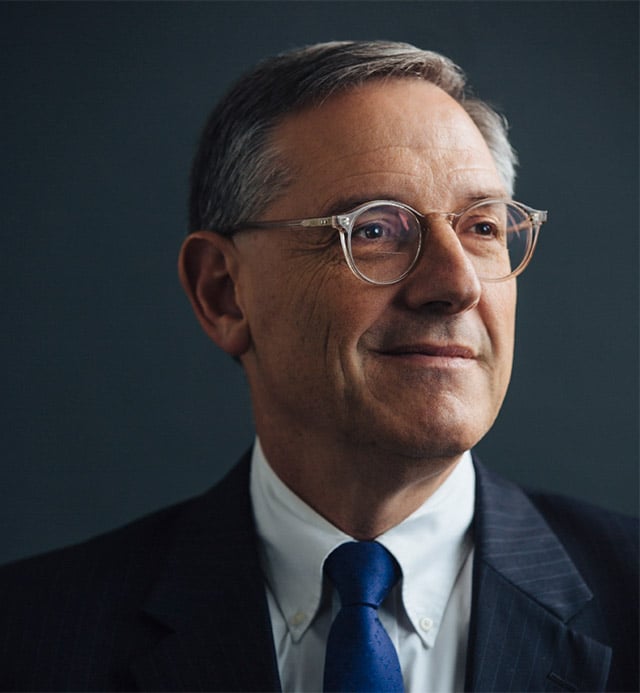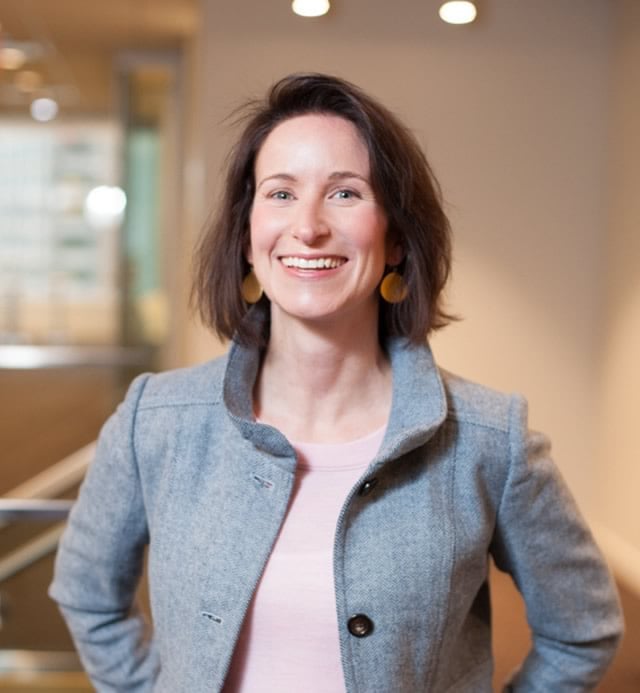-
Innovating Finance to Meet Emissions Reduction Goals: A Q&A with Peter Tufano
Reducing global greenhouse gas (GHG) emissions will require funding new technologies and developing infrastructure projects on an enormous scale, demanding fresh thinking about how to finance domestic and global projects.

Peter Tufano: Baker Foundation Professor, Harvard Business School; Senior Advisor, Salata Institute for Climate and Sustainability, Harvard University
As climate change concerns have grown, the complexity and magnitude of the ensuing energy transition have likewise increased. Decarbonization, electrification, and adaptation efforts will take place on a global scale, which will entail significant funding – both by governments and by investors at a variety of levels – and risk.
To make sense of both the opportunities and the challenges involved, Analysis Group Managing Principal Andrea Okie, Principal Todd Schatzki, and Vice President Anne Catherine Faye spoke to academic affiliate Peter Tufano. Professor Tufano – Baker Foundation Professor at Harvard Business School (HBS) and senior advisor at Harvard University’s Salata Institute for Climate and Sustainability – has been deeply engaged in studying and participating in the debates over business solutions to climate change, including climate finance, the workings of climate alliances, and the role of insurance in addressing climate issues. He designed and taught the first doctoral course on climate finance – working with colleagues from many other schools – and has led dialogues on climate finance with a variety of stakeholders. His research on the environmental, social, and governance (ESG) practices of firms relates firm ownership structure to preferences for ESG activities. He has also advised investors on meeting ESG targets.
Professor Tufano spoke with Ms. Okie, Dr. Schatzki, and Ms. Faye about the climate finance landscape, what financial innovations might be needed to meet GHG emissions goals, and whether and how companies can work together to advance a lower-carbon future.
Give us a high-level overview of what the climate finance picture looks like.
In order to reduce GHG emissions and transition to a lower-emission future, we need to commercialize and scale technologies that currently don’t exist while also funding an unprecedented number of infrastructure projects in developed and developing nations around the world. The funding that will be required is massive: One recent study estimated the gross cost of this undertaking at roughly $9.2 trillion annually over the next 25 years; in net terms, $2–3 trillion more per year than we currently spend.
Taking that figure as a baseline, estimates suggest that relatively little of it will be in the form of equity – that is, investment by investors purchasing ownership in companies. Infrastructure projects are mostly debt financed; as a result, the lion’s share will be funded by debt, which presents opportunities for innovation in the finance world, as well as risks. That creates new challenges as interest rates rise.
Let’s talk about the risks first. What should we know?
The US Energy Information Association (EIA) has estimated that two-thirds of the technology needed for future sustainability projects isn’t yet past the pilot stage. The organizations developing these technologies will need a lot of money to move forward. Funding new ventures is always a risky proposition. Unlike many of the big ventures that have been created in the last few decades – Google, Amazon, Facebook, and others – many climate ventures will be asset heavy and require deployment in existing systems and networks, and some will require substantial adoption and adaptation by corporate, national, and community partners.
In addition, while we have seen how these innovations can ultimately enjoy massive economies of scale, in the short run, lower-emission technologies may be more costly than the alternatives until scaled.
But you see a chance for innovation in the finance world that could at least mitigate some of these risks.
Definitely. At its core, financial engineering – which has had both amazing successes and failures – asks how we can structure contracts to reallocate risks to those most able and willing to bear them. Climate finance scholars and practitioners need to use this approach today, and many questions will have to be considered in a fresh way in order to tackle this situation.
At a macro level, climate change gives rise to transition risks and physical risks, which are risks of action and inaction, respectively. Investments seek to reduce these risks, but, in turn, give rise to standard commercial risks, although sometimes at new scales. If we can transform climate risks into commercial risks, we have a path forward, and the good news is that we have centuries of experience managing commercial risks. We know how to transform currency risks; to pool risks, sometimes between private parties and governments; to create portfolios of projects to diversify risks; and to divide risks into components that specific investors might be willing to bear. My fundamental belief is that if we can transform climate risks – that is, both transition risks and physical risks – into financial risks, we can make real progress.
Of course, governments – which ultimately means taxpayers and citizens – can serve as the funders and risk bearers of these projects. They can do this directly, for example, through investments in the form of the tax credits embodied in the Inflation Reduction Act (IRA). They can also do this through tax systems such as carbon taxes, which we see embodied in the EU Emissions Trading System or the more recent Carbon Border Adjustment Mechanisms, which tax high-carbon imports.
“We know how to transform currency risks; to pool risks, sometimes between private parties and governments; to create portfolios of projects to diversify risks; and to divide risks into components that specific investors might be willing to bear. My fundamental belief is that if we can transform climate risks – that is, both transition risks and physical risks – into financial risks, we can make real progress.”– Peter Tufano
Can you give an example of an innovation where the private sector might help to answer these questions, either alone or in conjunction with governments?
One of the simplest and oldest financial contracts is a forward contract, in which two parties agree today to transfer an asset in the future at a fixed price. No money changes hands up front in a forward contract, but it’s a binding buy/sell agreement. This general concept has been refined in the form of advance market commitments, or AMCs. Some of the early and well-covered uses of AMCs were to fund new vaccines: A set of buyers – in this case, governments and philanthropic organizations – committed to purchase doses in the future, giving companies incentives to invest in capacity building.
This concept has also been used in the climate space, where buyers pool future commitments for green products prior to a technology’s development, in order to reduce investor uncertainty by ensuring there is demand for the new technology. The First Movers Coalition, which has made commitments to green technologies in aviation, shipping, steel, and trucking, is an example. Another is Frontier, a consortium of corporations that have made AMCs to purchase permanent carbon removal solutions. Future buyers taking on some of the market risks faced by new products can lower the commercial risks faced by startups. This, in turn, can fortify investors with the confidence that these investments are attractive risk/reward propositions. In this case, a modern version of an ancient financial instrument can be used to reallocate risks and speed climate solutions.
You’ve advised some climate impact funds that invest in environmentally friendly projects. What stands out to you in the investment opportunity picture?
There are risks and potential rewards here as well. Investments cannot be classified as simply green or not green; rather, they exist along a continuum from, say, dark green to dark brown. And you can’t just look at their current “color” but also at how that color will change over time. One important and complex sector for transition finance is firms that currently are relatively brown but are on a transition path to becoming greener. Are their so-called transition paths simply public-relations gambits or greenwashing – or are they credible and backed up with corporate processes and actions? In the last year or so, we have seen an important shift in language: We are moving from talking about net-zero promises to transition paths. The former focuses solely on the future outcome, the latter on the complex journey to get there.
There are transition approaches that rely on lower-carbon technologies (e.g., natural gas, grey hydrogen), and other approaches that rely only on non-emitting technologies. Both have a role in how we lower overall GHG emissions and move to a net-zero future, as well as in investments and fund choices.
There will be tension for investors, but I think it’s also an opportunity. Rather than just seeing binary categories of green and brown, we will see true energy transition funds. The relevant question for investors will be: Are the investments in this fund making credible progress toward a lower-carbon future? If not, have the portfolio firms or the fund itself tried to make that progress but failed? Or have they never really tried, potentially giving rise to greenwashing concerns?
Finance is all about disparate parties joining together to bear risk. Your recent work focuses on how we may need more collaboration among firms to solve the climate crisis, yet antitrust concerns can prevent companies from working together to address climate change. What does that picture look like today, globally?
Climate change, like other systemic problems, requires work that cuts across nations, sectors, firms, and households. In short, solving the climate crisis is an “all hands on deck” problem. This will require that firms find new ways of collaborating. In a survey from a few years ago, more than 90% of firms said that businesses needed to collaborate to address the sustainability challenges that they face. Yet the degree to which climate collaboration among competitors is potentially treated as collusion varies greatly across the world.
For example, the UK and EU have, over the last several years, shifted toward a more flexible approach to evaluating competition concerns raised by sustainability initiatives among competitors. In other jurisdictions, there has been less movement on this issue. Although the Biden administration has identified climate change as a priority and called for a “whole-of-government approach,” federal antitrust agencies have to date been silent on or dismissive of sustainability exemptions to the antitrust laws. And certain state attorneys general have used threats of antitrust prosecution to slow the activities of net-zero alliances.
While the risks of climate change are real and current, we have to focus on how we can join forces to address it. This challenge of our lifetime demands that we think differently, act differently, and work together differently. As a scholar, educator, and business leader, I am convinced that this mandate speaks to the importance of critical and deep thinking, broadening our perspective to carefully consider our interconnections and the externalities we impose on one another and future generations, and to move from ideas to action. I remain hopeful. ■
From Forum 2024.




